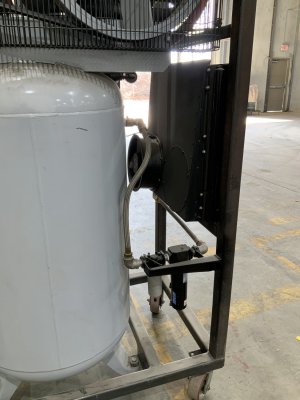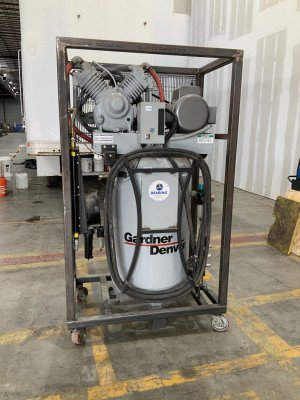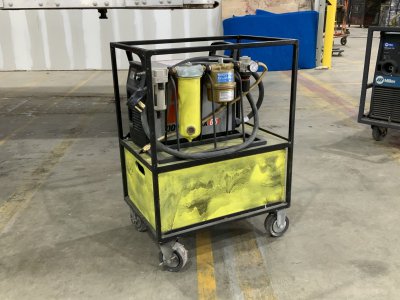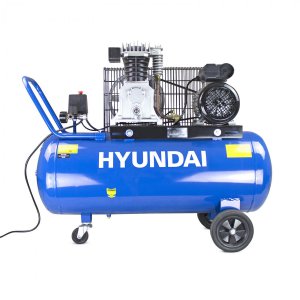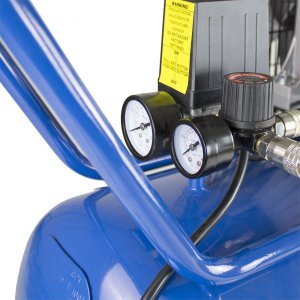- Joined
- May 27, 2016
- Messages
- 3,480
I have now got around to more seriously setting up my Hyundai 100L oil-based slow revs air compressor. The choice was deliberate. Longevity, reliability, and low(er) noise. I have in mind to add a more effective input port silencer, so call that a little "side project". It will be silenced, even if I have to move it out of the shop to it's own safe protected spot. But - it will have compressor oil. It does have a (sort of) tiny radiator on the way into the tank, which I suppose might drop out some water.
The very first need is to add some things with visibility bulbs to separate water, and oil. Here is where I run into a bewildering array of combinations, and poor descriptions of function. Mostly, the first place I look to see a range of stuff set out with prices is Amazon, and eBay, though I am very wary of the latter.
What do they do?
We start with very cheap two-bulb gadget that clearly has a place to drain water. So how does "lubricator" work? Does one "add oil" to it? Do some rely on not extracting the oil already in the compressed air (from the pump)?
Sometimes one bulb, sometimes two. Looking at the tiny block under the pressure gauge, it's hard to believe there is anything like a "real regulator" in there.
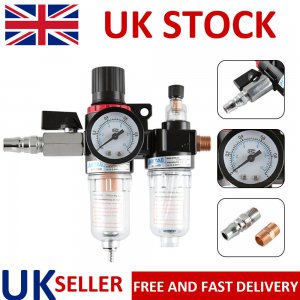 _ _ _
_ _ _ 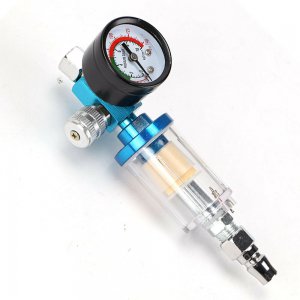
NPT or BSPT?
The advertisements might say 1/4", or simply 1/4. Some say NPT.
One can get NPT-BSPT thread adapters, but it helps to know what the threads in the gadgets are - and they don't say!
The compressor already has a regulator and gauge, and two air sockets to plug coiled pipes into.
I took one off, and the thread it has is 19TPI and is 0.518" at the fat end, which makes it 1/4" BSPT.
I don't need another regulator in there, but they are so cheap, it does not matter.
Air for spray paint must not have oil, nor water in.
Air for whizzy spinning tools should have oil. I have no idea what brad nailers like.
Since there are two outputs, I guess I could arrange one to be "clean, dry, oil-free", and the other to be maybe dry, but oiled up.
So here I ask - what kind of add-on cleanup filtration kit do you think is a good setup?
Also - I would much appreciate if someone could explain exactly how these work.
The very first need is to add some things with visibility bulbs to separate water, and oil. Here is where I run into a bewildering array of combinations, and poor descriptions of function. Mostly, the first place I look to see a range of stuff set out with prices is Amazon, and eBay, though I am very wary of the latter.
What do they do?
We start with very cheap two-bulb gadget that clearly has a place to drain water. So how does "lubricator" work? Does one "add oil" to it? Do some rely on not extracting the oil already in the compressed air (from the pump)?
Sometimes one bulb, sometimes two. Looking at the tiny block under the pressure gauge, it's hard to believe there is anything like a "real regulator" in there.
 _ _ _
_ _ _ 
NPT or BSPT?
The advertisements might say 1/4", or simply 1/4. Some say NPT.
One can get NPT-BSPT thread adapters, but it helps to know what the threads in the gadgets are - and they don't say!
The compressor already has a regulator and gauge, and two air sockets to plug coiled pipes into.
I took one off, and the thread it has is 19TPI and is 0.518" at the fat end, which makes it 1/4" BSPT.
I don't need another regulator in there, but they are so cheap, it does not matter.
Air for spray paint must not have oil, nor water in.
Air for whizzy spinning tools should have oil. I have no idea what brad nailers like.
Since there are two outputs, I guess I could arrange one to be "clean, dry, oil-free", and the other to be maybe dry, but oiled up.
So here I ask - what kind of add-on cleanup filtration kit do you think is a good setup?
Also - I would much appreciate if someone could explain exactly how these work.


